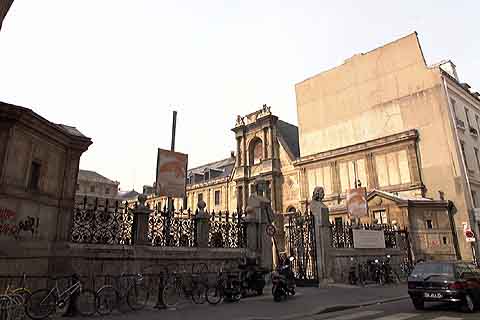School of arts founded in 1648 by Cardinal Mazarin developed studies in architecture, drawing, painting, sculpture, engraving, modeling, and gem cutting. The school was brought under control of the government by Louis XIV originally to guarantee a pool of artists available to decorate the palaces and paint the Royalty but was made independent by Napoléon III in 1863.
 |

|
The Ecole keyed on classical arts – Greek and Roman architecture and studying and imitating the Great Masters. Emphasis was placed on drawing before any of the students were allowed to advance to painting and each had to go through a rigorous progression of advancement. They first drew from engravings, also called drawing “from the flat”. Only when they mastered that, could they begin drawing from plaster casts or what was called drawing “from the round” or the “antique”; and then, and only then, were they allowed to progress and draw “from the live” (nude models).
When Sargent arrived in Paris in 1874, the art world was made up of three very separate bodies which coexisted symbiotically in a triangle with a fourth filling the center. At the top of this triangle was the dignified Ecole, steeped in tradition and hopelessly stiff, designed to produce classical painters in an emerging world that was excited by new artists pushing at the fringes (Manet and others). Still, the Ecole was the apex of recognized achievement, with established levels of exams deemed so difficult that it was considered the best in the world. To be accepted by the Ecole was to be considered the best; and although a revolution in art was taking place – it wouldn’t hit the mainstream until much later. Every year the Ecole held a contest for the Grand Prix de Rome. The winner would get a full-ride scholarship to study in Rome.
The second point in this triangle was the small independent ateliers where students learned directly under the tutelage of an established “Master” who were not part of the Ecole. Students not in the Ecole trained in these ateliers with the hopes of passing the entrance exam, as well as students already in the Ecole wanting to get recognized by their association with a known "practicing Master".
The Masters ran their ateliers as a status symbol of their greatness. The success their students had at the Ecole and the Salon only reflected back on them as to how great they truly were. In turn, their student's success and status only brought more commissions. Success bred success. The greater the Master, the more talented students wanted to associate and align themselves to a proven track record -- both at the Ecole and the Salon. The competition between the independent ateliers meant the Ecole could raise the bar even higher guarantying they would get only the best of the best.
The third point in the triangle was the annual Paris Salon, the show everyone wanted to succeed at, and from which the public often commissioned their favorite artists. It was the place to be seen, get known, and paintings shown at the Salon often posted not only the artist who did the work, but what atelier they came from and whom they studied under. It was the Paris Salon that was the culmination of a full years worth of work, both at the Ecole and the ateliers. Not every painting was accepted. You had to submit to a jury to get the paintings shown. Over the summer break, the Masters, teachers, and students were almost all expected to leave the city, travel and paint in plein air.
In the middle of these three bodies was the lively Parisian life of the cafés which all came together to discuss art. They literally lived, breathed, and drank art -- twenty-four seven. The cafés were but informal extensions of the ateliers and the Ecole, and the Masters would hold court at a table of their followers to argue and discuss theories and technique -- and when the Salon was going -- critique art. It would be the cafés that the vanguard of art flourished and from which the Impressionists came.
Wholly aside from the discipline of painting, was the discipline of Architecture and was one of the most important studies at the Ecole des Beaux-Arts and would influence a whole school of thought. From America came some of the best students to study and it would the Beaux-Arts that buildings such as the Boston Public Library, Boston Museum of Fine Arts, Grand Central Station, The Metropolitan Museum of Art, and many of the Great public buildings in America of the late 1800's through the 1930's were built.
Today, the Ecole still exists although the Architectural school was split off after the student riots of 1968.
Notes
Here are some OUTSTANDING
links
to further reading and viewing.
- History of the Ecole- Learn more about exams and the famous Grand Prix de Rome
- Learn more about the Architectural style Beaux-Arts Classicism
- See some of the buildings built in America of this style including the Boston Public Library -- Digital Archive of American Architecture
- See today's Ecole nationale supérieure des beaux-arts
- The Ecole des Beaux-Arts
- The Independent Ateliers
- The Annual Paris Salon
Drawing
from the “antique”
John
Singer Sargent
|
Date: unknown appears to be late 1800's Source: History of the Ecole des Beaux-arts |
|
Edouard Manet (French Painter) 1878 |


The
Ecole des Beaux-Arts

Photo:
Contemporary photo
Date:
unknown
Source: PagesZoom.com
